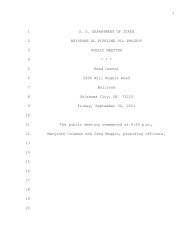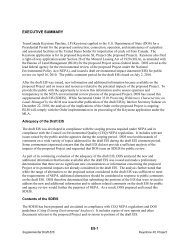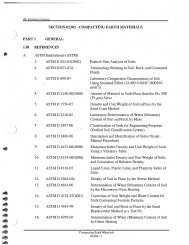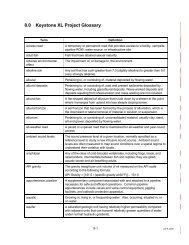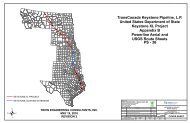2.1 Overview of the Proposed Project - Keystone XL pipeline - US ...
2.1 Overview of the Proposed Project - Keystone XL pipeline - US ...
2.1 Overview of the Proposed Project - Keystone XL pipeline - US ...
Create successful ePaper yourself
Turn your PDF publications into a flip-book with our unique Google optimized e-Paper software.
Draft Supplemental Environmental Impact Statement<strong>Keystone</strong> <strong>XL</strong> <strong>Project</strong>commercially navigable waterway, <strong>the</strong> last operator <strong>of</strong> that facility must file a report uponabandonment <strong>of</strong> that facility. The report must contain all reasonably available informationrelated to <strong>the</strong> facility, including information in <strong>the</strong> possession <strong>of</strong> a third party. The report mustcontain <strong>the</strong> location, size, date, method <strong>of</strong> abandonment, and a certification that <strong>the</strong> facility hasbeen abandoned in accordance with all applicable laws.TransCanada (<strong>the</strong> parent company <strong>of</strong> <strong>Keystone</strong>) would adopt operating procedures to address<strong>the</strong>se requirements for <strong>the</strong> proposed <strong>Project</strong> as <strong>the</strong>y have for previous <strong>pipeline</strong> projects including<strong>the</strong> existing <strong>Keystone</strong> Pipeline. TransCanada typically does not abandon large-diameter <strong>pipeline</strong>sbut generally idles or deactivates pipe as market conditions dictate. This allows a dormant<strong>pipeline</strong> to be reactivated or converted to ano<strong>the</strong>r purpose in <strong>the</strong> future, subject to applicableregulatory approvals. When a <strong>pipeline</strong> or a segment <strong>of</strong> a <strong>pipeline</strong> is idled or deactivated, <strong>the</strong> pipegenerally is purged <strong>of</strong> its contents, filed with an inert gas, and left in place with warning signageintact. CP would likely be left functional as would o<strong>the</strong>r integrity measures such as periodicinspections under <strong>the</strong> integrity management plan.The proposed <strong>Project</strong> <strong>pipeline</strong> would traverse approximately 45 miles <strong>of</strong> federal land under <strong>the</strong>management and jurisdiction <strong>of</strong> <strong>the</strong> Bureau <strong>of</strong> Land Management (BLM).All <strong>of</strong> <strong>the</strong> federal landis in <strong>the</strong> state <strong>of</strong> Montana. The portion <strong>of</strong> <strong>the</strong> proposed <strong>Project</strong> that would cross BLMadministeredland would be subject to <strong>the</strong> <strong>pipeline</strong> decommissioning and abandonmentrequirements stipulated in <strong>the</strong> BLM ROW grants and permanent easement permits. Theserequirements are:• Boundary adjustments in oil and gas would automatically amend <strong>the</strong> right-<strong>of</strong>-way to includethat portion <strong>of</strong> <strong>the</strong> facility no longer contained within <strong>the</strong> above. In <strong>the</strong> event an automaticamendment to this right-<strong>of</strong> way grant, <strong>the</strong> prior on-lease/unit conditions <strong>of</strong> approval <strong>of</strong> <strong>the</strong>facility would not be affected even though <strong>the</strong>y would now apply to facilities outside <strong>of</strong> <strong>the</strong>lease/unit as a result <strong>of</strong> a boundary adjustment. Rental fees, if appropriate would berecalculated based on <strong>the</strong> conditions <strong>of</strong> this grant and <strong>the</strong> regulations in effect at <strong>the</strong> time <strong>of</strong>an automatic amendment.• Prior to termination <strong>of</strong> <strong>the</strong> right-<strong>of</strong>-way, <strong>the</strong> holder would contact <strong>the</strong> authorized <strong>of</strong>ficer toarrange a predetermination conference. This conference would be held to review <strong>the</strong>termination provisions <strong>of</strong> <strong>the</strong> grant.• Prior to termination <strong>of</strong> <strong>the</strong> right-<strong>of</strong>-way, <strong>the</strong> holder would contact <strong>the</strong> authorized <strong>of</strong>ficer toarrange a joint inspection <strong>of</strong> <strong>the</strong> right-<strong>of</strong>-way. This inspection would be held to agree to anacceptable termination (and rehabilitation) plan. This plan would include, but is not limitedto, removal <strong>of</strong> facilities, drainage structures, or surface material, recontouring, topsoiling, orseeding. The authorized <strong>of</strong>ficer would approve <strong>the</strong> plan in writing prior to <strong>the</strong> holder’scommencement <strong>of</strong> any termination activities.The ROW grant on federal lands under <strong>the</strong> management <strong>of</strong> BLM for <strong>the</strong> proposed <strong>Project</strong> wouldhave a maximum term not-to-exceed 30 years. For <strong>the</strong> proposed <strong>Project</strong> to extend beyond 30years, <strong>the</strong> approved ROW grant would require a renewal authorization-certification decision byBLM. While <strong>the</strong>re are no state regulations applicable to <strong>pipeline</strong> decommissioning in Montana,South Dakota, or Nebraska, environmental specifications developed by Montana Department <strong>of</strong>Environmental Quality that would address reclamation <strong>of</strong> areas disturbed during abandonmentwould be required.<strong>Project</strong> Description <strong>2.1</strong>-87 March 2013



